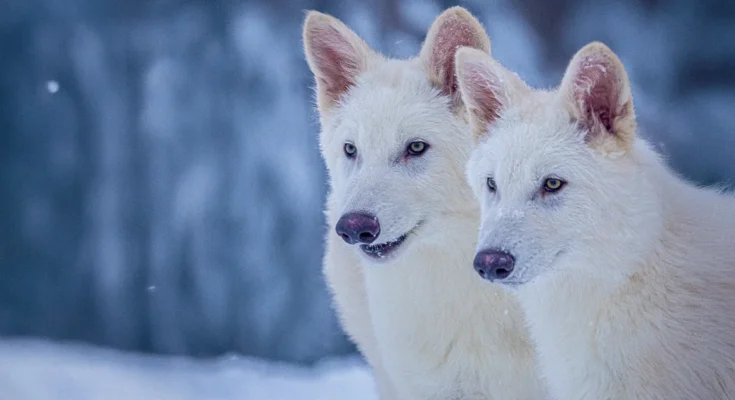A species of wolf that went extinct around 12,500 years ago has been brought back to life as the “world’s first successfully de-extincted animal,” according to Dallas-based biotech company Colossal Biosciences.
Colossal scientists have created three dire wolf pups by using ancient DNA, cloning, and gene-editing technology to modify the genes of a gray wolf, the closest living relative of the prehistoric dire wolf. The result is a hybrid species that closely resembles its extinct ancestor.
The dire wolf, Aenocyon dirus, which inspired the fearsome canine seen in the HBO series “Game of Thrones,” was once a top predator that roamed North America. (HBO shares its parent company, Warner Bros. Discovery, with CNN.) Dire wolves were larger than gray wolves, with “a slightly wider head, thick light fur, and stronger jaws,” according to Colossal Biosciences.
Since 2021, Colossal has been working on resurrecting the mammoth, dodo, and Tasmanian tiger, but the company had not previously disclosed its efforts to bring back the dire wolf.
“This significant milestone is just the first of many to demonstrate that our complete de-extinction technology stack is effective,” said Ben Lamm, Colossal’s cofounder and CEO, in a press release. “Our team used DNA from a 13,000-year-old tooth and a 72,000-year-old skull to create healthy dire wolf puppies.”
The three dire wolves now live on a 2,000-acre site at an undisclosed location, enclosed by 10-foot-tall “zoo-grade” fencing. They are monitored by security personnel, drones, and live camera feeds. Colossal stated that the facility is certified by the American Humane Society and registered with the U.S. Department of Agriculture.
Dire Wolf Fossils and Ancient DNA
By extracting ancient DNA from two dire wolf fossils, Colossal’s scientists and collaborators successfully assembled two high-quality Aenocyon dirus genomes, or complete genetic profiles.
The team then compared these genomes with those of living canids, such as wolves, jackals, and foxes, to pinpoint the genetic variants responsible for traits unique to dire wolves, including their white coats and long, thick fur.
The company used the genetic analysis to modify gray wolf cells, making 20 edits across 14 genes before cloning the most promising cell lines and transferring them into donor eggs, according to the news release.
“Healthy developing embryos were then transferred into surrogates for interspecies gestation,” resulting in three pregnancies that led to the birth of the first de-extinct species, Colossal revealed. The company confirmed to CNN that domestic dogs, specifically large, mixed-breed hounds, were used as surrogates.
Two male dire wolf pups were born on October 1, 2024, and a female pup was born on January 30, 2025, according to Colossal Biosciences.

Gene Editing for De-Extinction
To reach its goal, the company essentially created a hybrid genome using CRISPR technology, removing specific gray wolf gene variants and replacing them with traits linked to dire wolves, explained Love Dalén, a professor of evolutionary genomics at the Centre for Palaeogenetics at Stockholm University and an adviser to Colossal.
“There’s no secret that, across the genome, this is 99.9% gray wolf. There will likely be debate in the scientific community about how many genes need to be altered to create a true dire wolf, but ultimately, that’s a philosophical question,” Dalén said.
“It carries dire wolf genes, and these genes make it resemble a dire wolf more than anything we’ve seen in the last 13,000 years. And that’s really exciting.”
Dalén, who noted that he had been “a little bit” involved in analyzing the dire wolf genomes but had not met the dire wolf pups or participated in the gene editing or cloning process, called the scientists’ work a “huge leap” from anything previously done in the field.
“As I see it, they’ve resurrected the dire wolf phenotype (the observable traits of a species), and from the genome, we can tell they probably looked something like these puppies. To me, that makes it a dire wolf,” he explained.
Since Lamm, a serial entrepreneur, and Harvard University geneticist George Church founded Colossal in September 2021 and announced their plans to resurrect the mammoth, the company has raised at least $435 million. While the mammoth project has taken longer than originally expected, Colossal stated it is on track to introduce the first woolly mammoth calves in 2028.
The company believes the same technologies used to create the dire wolf could also help endangered species. On Monday, Colossal announced that it has produced two litters of cloned red wolves—the most critically endangered wolf species—using a new, less invasive cloning method developed during the dire wolf research.
Many critics of de-extinction argue that the substantial funds invested in the project could be better spent elsewhere and that breeding these hybrid creatures could put living animals used as surrogates at risk. However, Christopher Preston, a professor of environmental philosophy at the University of Montana, noted that Colossal appears to be prioritizing animal welfare, pointing to the size of the facility and its support from the American Humane Society.
“Colossal has taken careful precautions to avoid unintended genetic consequences, eliminating risky edits known to lead to poor outcomes,” he added.
Despite this, Preston questioned the role the dire wolves could play in an ecosystem, which is the ultimate goal of Colossal’s efforts to create genetically engineered mammoths.
“In states like Montana, we’re already struggling to maintain a healthy gray wolf population due to increased political opposition,” Preston said. “It’s hard to imagine dire wolves ever being released and taking on an ecological role. So, it’s important to ask what function these new animals will actually serve.”



